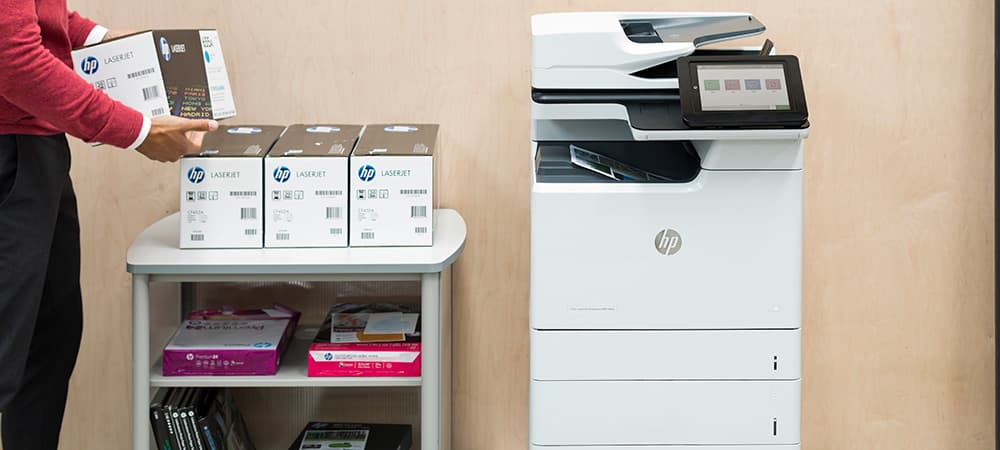We use cookies to offer you a better experience. For more information on how we use cookies you can read our Cookie and Privacy Policy.
The Differences Between Printer Toner vs Ink

There are many differences between toner and ink, from the printing process to the type of cartridge you’ll use in your device. While ink is standard in most conventional inkjet home printers, laser printers depend on toner and lasers for their output. Given that they’re based on their own unique technology, you’ll find that they also have their own unique advantages and disadvantages.
Laser printing is often thought of as being used in larger offices and businesses, but the technology has become more commonplace. Laser printers built to handle efficient toner cartridges are more and more accessible every year thanks to ongoing improvements, a diverse printer market, and the variety of consumers with their own unique requirements.
If you aren’t familiar with just how efficient toner-based laser printers can be, it’s probably worth getting better acquainted with the technology. Of course, which format you prefer, laser or ink, depends heavily on how you actually use your printer. How much you print and what you’re printing can have a bigger impact on maintenance and costs than you may imagine.
Getting up to speed with both formats
Let’s first discuss how the two technologies work, then we’ll take a look at the advantages of both. We’ll explore the potential impact on your budget, print speed and accuracy, high-volume printing, and more specialized needs like photo and color printing. Despite the many technical differences between ink and toner, these characteristics are important for all users.
And in case you still have some outdated assumptions about purchasing a toner printer vs an ink printer, we’ll cover each feature in detail. For now, the biggest public misconception about laser printing is most tied to size and costs. It’s still easy to assume that all laser printers are desk-hogs and way more expensive than their inkjet counterparts.
Fortunately for individuals users, new business owners, and any professional with a big need for long-term print quality, those days are over. Thanks to new and improved technology, there are more budget-friendly and compact laser configurations to choose from than ever. In the HP® printer selection alone, you’ll find a great variety whether you want the latest laser printer for printing loads of documents or a versatile inkjet printer for more mixed output.
Now, let’s look at how each technology works, starting with the traditional inkjet printer, a workhorse device that’s especially great for homes and families.
What is an inkjet printer?
Most consumer printers that use ink cartridges are known as inkjet printers. While some inks are formulated differently from others, they all depend on a liquid base and some sort of coloring agent. For many home users, this is the familiar standard. Inkjet printers essentially make home printing a breeze, and they’re sure to remain useful for years to come.
The basics of inkjet printing
Named after the thermal inkjet process that uses heat and physics to control ink distribution during printing, these printers have been around for decades. Their nozzles are basically supervised by the printer’s built-in software, and they spray tiny drops of ink across each sheet of paper to produce a print.
The process is most efficient when you print in just black and white. You’ll then experience a little extra delay for color and photo prints so that your printer can create the right composition for each image or graphic. That’s why you’ll typically experience a small difference in black vs color print times with inkjet, but it’s usually relatively minimal.
Ink supply and cartridge configurations
For their ink supply, most inkjet printers are loaded with either two or four cartridges in total. You’ll always find one cartridge devoted to black ink and either three individual color cartridges (cyan, magenta, and yellow) or a single tri-color cartridge. The tri-color cartridge blends all three inks each time it prints to achieve clarity close to using dedicated color cartridges.
Tri-color cartridges can definitely be more convenient and save space in smaller printer designs. They also save you a little money compared to buying three separate color cartridges. However, they’re often less efficient because if one color runs low, you have to replace the entire cartridge.
What is a toner printer?
If you’re wondering if toner is at all similar to ink, the short answer is that they’re light years apart. While inkjet printers depend on a liquid medium with an added coloring agent, laser printers work by projecting a unique electrostatic charge against a printing drum. This is essentially how your printer defines whatever it’s printing with each job, whether it’s text or simple images.
How does toner work?
Usually stored in a single cartridge, printer toner is a powder-based print medium made from granulated plastics that allows for greater accuracy and control. Toner powder is collected and then transferred to paper by the charged printing drum. As a final step, the paper is heated to melt the toner particles and help make sure that your print sets properly.
The drum’s electrostatic charge is imprinted by lasers, hence the term “laser printer.” While laser printing mostly involves black-and-white prints, you can find color options with the aforementioned four-cartridge configuration.
Meet the HP LaserJet family
In addition to pioneering inkjet printers, HP® also revolutionized business printing in 1984 with the introduction of the first LaserJet printer. It offered numerous improvements over the noisier and clunkier alternatives, and was also the world’s first desktop laser printer. According to the official history, “LaserJet was virtually silent; office personnel could talk on the telephone while sitting next to the laser printer as it produced documents.” [1]
Extremely quiet and small enough to store out of the way, the first HP LaserJets helped displace older, bigger formats like the daisy wheel printer. These loud, hefty devices are easily recognizable due to their physical resemblance to typewriters. By creating a more efficient option for general document printing, HP’s laser printers helped streamline how the world does business.
The advantages of inkjet printing
Inkjet plays a major role in the printing world, and often as a complement to a laser printer in an office setting or even at home. While laser is great for an office with large-scale document needs, the versatility of inkjet cannot be overstated.
1. Smaller physical footprint and checkout price
While smaller laser printers are becoming commonplace, an inkjet printer remains your most compact option. Some inkjet printers are also much cheaper than their laser counterparts at checkout. Consider standout models like the HP DeskJet 1112 printer, which offers access to HP’s high-yield cartridges at a very accessible price point. Even though you may need to replace ink more often than toner, models like the HP DeskJet prove that you can find an affordable, space-saving printing solution.
2. Superior format for color and photo printing
Thanks to their superior ability for color blending and support for more paper types, inkjet printers are generally best for photo prints. This can be a real advantage if you share family memories, print complex images or graphics, or produce anything that needs to be as clear as possible.
Even so, it’s worth addressing the misconception that toner printers can only print black. While inkjet is the most reliable option for complex images and photos, nearly half of HP’s toner printers are well-equipped for color printing.
3. Better for users with varied needs
For users with more varied needs who aren’t printing page after page of text, inkjet tends to win out. With a cheaper introductory price and better color prints, an inkjet printer is a great option for low-volume print users. You can handle everything you need as it arises.
Services like HP Instant Ink also make getting replacement ink cartridges more affordable and convenient. Any printer compatible with the service automatically detects low ink and orders replacements for you. All you have to do is set up a plan based on your printing volume. For anyone with a predictable print routine, HP Instant Ink is a fantastic way to save money and time.
The advantages of toner printing
Let’s now take a look at the advantages of printer toner.
1. More affordable for high-volume print users
The most important advantages of printer toner and laser printers are the minimal waste and reduction in recurring supply costs. Laser printers are typically a little more expensive during the initial purchase, but the overall savings actually boil down to our original comparison: printer toner vs ink?
While ink is still relatively expensive to refill or replace, toner powder is much more affordable over time. This also makes it more efficient and less wasteful because inkjet cartridges often force users to refill or replace them before they’ve been completely depleted.
In short, laser printers are a great option for your biggest projects, such as long documents or drafts, while ink can take care of just about anything else. For offices or professionals who often find themselves with varied or unplanned needs, a compact HP LaserJet paired with an even smaller inkjet is a great way to tackle everything you need.
2. Higher precision prints
Of course, it’s still possible to get great quality, precision prints from inkjet, but the technology and toner involved with laser printing promises greater reliability. For instance, with toner you don’t face the same risk of bleeding or smudging that you can face with ink. This means you can enjoy more consistency and better quality with bigger print projects.
3. Better print speeds on average
Toner printers are also generally much faster than inkjet printers, which is another reason why they’re so desirable for high-volume printers. Not only do they save you money on all your print supplies, but they also average high enough print speeds that you won’t have to worry about having to sit around while it handles big jobs.
You’ll find plenty of models with truly high-print speeds, some stretching upwards of the 50 page per minute mark. Even the affordable HP LaserJet Pro M402dne can offer as many as 40 pages per minute.
Powerful HP LaserJet and InkJet printers
Clearly, inkjet and laser both have a huge role in printing, and if you need a new device in your home, office, or elsewhere, HP® has got you covered.
For those with low-volume home printing needs who are also shopping on a budget, consider the HP DeskJet 3755 All-in-One printer. It’s one of the world’s smallest AiO printers and provides great print quality for varied routines. It also has copying and scanning capabilities.
If you’re going to print at a higher volume, you should explore laser options. If you just need black-and-white toner to print documents, the HP LaserJet Pro M15w printer is one of the smallest and most affordable printers of its kind.
You can even shop for color HP LaserJets like the super-compact and affordable HP Color LaserJet Pro M254dw, up to a print powerhouse like the HP Color LaserJet Enterprise Flow MFP M682z. Plus, since HP’s acquisition of Samsung’s printer division, you can also find a great selection in the Xpress and ProXpress lines.
There is no real “winner” in a toner printer vs ink printer comparison. You have to keep your routine in mind, not only what you do now but what you may be doing in a few years. Each format has its own unique advantages and features, so your choice will come down to more than just comparing toner vs ink cost.
There are also good reasons to have both printer types in your office suite. Owning an HP LaserJet as your hub for bulk prints and an HP InkJet for color and photos is a common arrangement. It provides a compromise that can also translate to cost and resource savings over time.
About the Author: Dwight Pavlovic is a contributing writer for HP® Tech Takes. Dwight is a music and technology writer based out of West Virginia.
Article reposted with permission from HP Tech Takes






